Aug 31
Posted: under Activities, Wildlife.
Tags: Activities, Animal behavior, photography, reptile behavior, wildlife management August 31st, 2009
Several times in the past couple of years we’ve had to get a turtle out of the fence. The horse lots fencing is pipe with welded-mesh cattle panels welded to the pipe–so there’s a pipe at the bottom. Good safe horse fence, but not easy for turtles to maneuver through/around and turtles don’t seem to […] [...more]
Several times in the past couple of years we’ve had to get a turtle out of the fence. The horse lots fencing is pipe with welded-mesh cattle panels welded to the pipe–so there’s a pipe at the bottom. Good safe horse fence, but not easy for turtles to maneuver through/around and turtles don’t seem to have the idea of paralleling a fence to find a gap.
So yesterday evening, shortly before dark, the horses were acting freakish in the barn and south barn pen, and Richard spotted a good-sized turtle. I came out with the camera and first saw this:
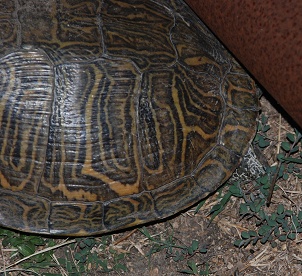
Read the rest of this entry »

Apr 09
Posted: under Plantlife, Update, Wildlife.
Tags: census, native plants, wildlife management April 9th, 2009
http://www.80acresonline.org/ Species lists are now live on the website. When you mouse over the Species List, three choices appear: birds, plants, and “zoology” (which in this instance means non-bird wildlife.) And each of these lists has three pictures of representative species up there on the top green line. So if you’re been wondering what we […] [...more]
http://www.80acresonline.org/
Species lists are now live on the website. When you mouse over the Species List, three choices appear: birds, plants, and “zoology” (which in this instance means non-bird wildlife.)
And each of these lists has three pictures of representative species up there on the top green line.
So if you’re been wondering what we have…there it is.

Mar 31
Posted: under photography, Wildlife.
Tags: beauty, butterflies, photography, wildlife management March 31st, 2009
Monarchs come through central Texas in both the spring and fall migrations. In spring, they particularly need wild milkweeds on which to lay eggs, but they also need flowers that provide nectar, in case they must fly farther to find the milkweeds (and this year, that’s important. Because of drought, the milkweed abundance is way […] [...more]
Monarchs come through central Texas in both the spring and fall migrations. In spring, they particularly need wild milkweeds on which to lay eggs, but they also need flowers that provide nectar, in case they must fly farther to find the milkweeds (and this year, that’s important. Because of drought, the milkweed abundance is way down on our place.)
I usually see monarchs mating while perched on Ashe junipers–as wind protection–and nectaring on whatever’s blooming. Some years, they have a choice. This year, because of the drought, not much choice. The reliable woody shrubs bloom even when the flowering forbs are scarce. Rusty blackhaw viburnum and wild plum (both the Mexican plum and the thicketing plum) provided monarch feeding stations this year.
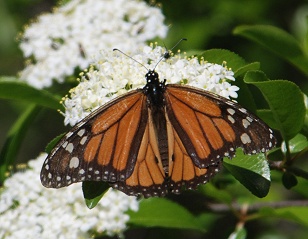
This particular viburnum overhangs the creekbed (now dry) and is at least twenty feet tall. Sunday it was covered with white flower clusters. Since we’ve owned the place, excluding livestock from the creek woods has allowed the growth of new viburnums, so in another ten to twenty years, we should have a lot of flowering shrubs–and some very happy monarchs.
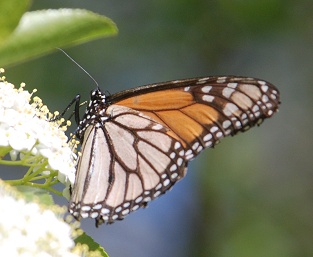
Read the rest of this entry »

Mar 09
Posted: under photography, Plantlife, Wildlife.
Tags: beauty, native plants, photography, wildlife management March 9th, 2009
We saw a Luna Moth again today. It might have been the same one or another one. This was in the mid-morning of a cloudy day, with a strong wind from the S (the other side of the fence. The white “frosting” on the forewing purple stripe is (when really enlarged) white scales mixed with […] [...more]
We saw a Luna Moth again today. It might have been the same one or another one. This was in the mid-morning of a cloudy day, with a strong wind from the S (the other side of the fence.
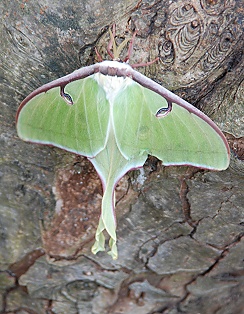
Luna Moth
The white “frosting” on the forewing purple stripe is (when really enlarged) white scales mixed with the purplish ones. You can just see the underwing eyespots showing through.
Read the rest of this entry »

Mar 04
Posted: under Land, Plantlife, Weather, Wildlife.
Tags: beauty, native plants, photography, Weather, wildlife management March 4th, 2009
Even in a year this dry, some of the native plants (and a few non-natives) do their best to keep alive and growing. One of the natives we’ve nurtured for years in the yard is the scarlet buckeye, an understory tree that hates sun and drought–but thrives in shady canyons near permanent water. Our version […] [...more]
Even in a year this dry, some of the native plants (and a few non-natives) do their best to keep alive and growing.
One of the natives we’ve nurtured for years in the yard is the scarlet buckeye, an understory tree that hates sun and drought–but thrives in shady canyons near permanent water. Our version of that is the shade of a big old ash and regular watering. I’d like to move its progeny into the creek woods, but right now they’re far too dry (and too far away to water.) It’s just showing its flower buds now; they’ll be open in a few days.
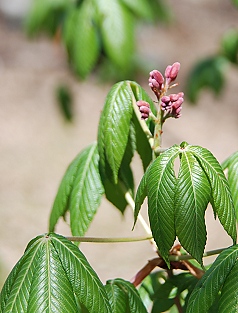
Read the rest of this entry »

Jan 18
Posted: under Activities, photography, Plantlife, Wildlife.
Tags: Activities, photography, wildlife management January 18th, 2009
Yesterday was the “nose to the grindstone” day for putting the annual report in final form, including choosing which pictures to include to show the story of the year on our place. The official form has nine pages. Add to that a cover sheet with our names and other useful information the form itself doesn’t […] [...more]
Yesterday was the “nose to the grindstone” day for putting the annual report in final form, including choosing which pictures to include to show the story of the year on our place.
The official form has nine pages. Add to that a cover sheet with our names and other useful information the form itself doesn’t have space for, and three pages of supplementary notes referencing specific points of the form (which, for instance, does not have a check-box for “check-dams/gabions” under “erosion control”–just ponds, dykes, and levees, so I have to add a note about our check-dams and gabions every year) , and then 14 pages that I call the Activity Report, detailing (well, outlining, but in more detail than their Annual Report Form makes possible) the activities we’ve done in each of the seven management areas with (where possible) photographs.
(Photos beyond the break)
Read the rest of this entry »

Jan 12
Posted: under Activities, Plantlife, Wildlife.
Tags: Activities, Animal behavior, beauty, observation, photography, supplemental feeding, wildlife management January 12th, 2009
Today’s wildlife experience was an armadillo, drinking noisily (they slurp, sounding rather like dogs) from the overflow guzzler at Fox Pavilion when we came back around that way after a long, two-hour stroll around the place. I thought I’d turned the water off completely, but some grit must’ve been in the faucet, because the water […] [...more]
Today’s wildlife experience was an armadillo, drinking noisily (they slurp, sounding rather like dogs) from the overflow guzzler at Fox Pavilion when we came back around that way after a long, two-hour stroll around the place. I thought I’d turned the water off completely, but some grit must’ve been in the faucet, because the water had overflowed.
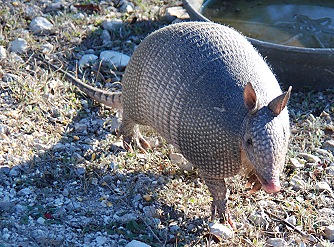
Read the rest of this entry »

Jan 09
Posted: under Activities, Wildlife.
Tags: bird behavior, photography, supplemental feeding, wildlife management January 9th, 2009
We have four or five different bird populations on the place, and the first year I thought the winter-resident bunch were the dullest. After all, it’s not their breeding season, so those that have a bright breeding plumage don’t have it here. Then there are the sparrows–for two years they defeated my attempts at bird […] [...more]
We have four or five different bird populations on the place, and the first year I thought the winter-resident bunch were the dullest. After all, it’s not their breeding season, so those that have a bright breeding plumage don’t have it here. Then there are the sparrows–for two years they defeated my attempts at bird identification because I didn’t spend enough time learning which small streaky brown bird was which.
Then I spent a winter sitting out in the dry woods with binoculars day after day and discovered the beauty of winter sparrows. Now the winter birds are one of my favorite subgroups. They can’t compete with the painted buntings we get in late spring (nothing can!) but I enjoy them. And the American goldfinches, arriving all brown, with the black-and-white echelons of their wingtips on the back, gradually transform toward spring into the familiar yellow and black northerners see.
Read the rest of this entry »

Nov 29
Posted: under Activities, Wildlife.
Tags: beauty, photography, wildlife management November 29th, 2008
Here beginneth the 80 AcresOnline blog…where I’ll be talking about our wildlife management project and other nature-related topics from time to time. Construction’s still going on at the website, so expect only short bits here for awhile. Today’s walk? Color, color, color: flameleaf sumac (aptly named), yellow elbowbush and Mexican buckeye, rich red rusty blackhaw […] [...more]
Here beginneth the 80 AcresOnline blog…where I’ll be talking about our wildlife management project and other nature-related topics from time to time. Construction’s still going on at the website, so expect only short bits here for awhile.
Today’s walk? Color, color, color: flameleaf sumac (aptly named), yellow elbowbush and Mexican buckeye, rich red rusty blackhaw viburnum, pink-through-rose-to-purple roughleaf dogwood. Yellow and orange butterflies, including one lone monarch vainly trying to fly into a stiff north wind.







